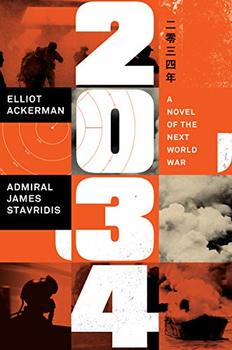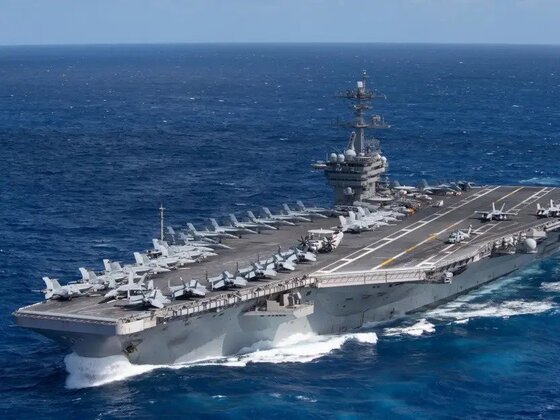
A squadron of three US destroyers sails on a “freedom of navigation” mission in the disputed waters of the South China Sea. Nearby a smaller vessel is gushing smoke, and Captain Sara Hunt, the squadron’s commodore, orders her warships to veer off course to investigate. They find a small craft packed with electronic surveillance equipment, which they seize. And this ill-considered act in March 2034 triggers a succession of shocking events that unfold over the next four months. Not the rapid-fire, tit-for-tat exchange of strategic nuclear weapons conjured up in the most common fantasy of a Third World War. Just a slow-motion disaster with its own tragic and far-reaching consequences. Thus begins 2034: A Novel of the Next World War. It’s the most frightening book I’ve read in many years.
Estimated reading time: 7 minutes
While Sara Hunt’s squadron is engaged off the China coast, another drama is unfolding half the world away. US Marine pilot “Wedge” Mitchell’s F-35 is on a provocative test flight into Iranian airspace over the Strait of Hormuz. Suddenly, all the electronics that control the aircraft stop working. The plane is under someone else’s control, and slowly it circles on its way down to the massive Iranian military base at Bandar Abbas.
For Sandeep Choudhury, the US Deputy National Security Adviser working in the White House, these two events appear unconnected. But he will soon learn they are both the product of a Chinese-Iranian alliance. And they represent the opening salvos in a complex and risky plan hatched within China’s Central Military Commission.
And no one has a clue that the actions they all take will help set off the Third World War.
2034: A Novel of the Next World War by Elliot Ackerman and Admiral James Stavridis (2021) 320 pages ★★★★★

An international cast of characters
Merely listing the principal characters in this sprawling story offers a clear sense of its scope. Here they are, in alphabetical order by their last names.
- The Chinese Defense Minister, General Chiang, head of the Central Military Commission
- Dr. Sandeep Choudhury, deputy US National Security Adviser
- Brigadier General Qassem Farshad of the Quds Force in the Iranian Revolutionary Guards
- US Navy Rear Admiral John T. (“Bunt”) Hendrickson, a senior Pentagon official
- Lieutenant Commander Vasily Kolchak, executive officer of the Russian Navy corvette Reskiy
- US Navy Captain Sara Hunt, commanding three destroyers in the South China Sea
- Admiral Lin Bao, Chinese military attaché in Washington, DC
- Major Chris “Wedge” Mitchell, a US Marine F-35 pilot
- Retired Vice Admiral Anand Patel, formerly second in command of the Indian Navy
In the action that unfolds from March through July, 2034, every one of these characters plays a pivotal role. The countries they represent—China, the US, Iran, Russia, and India—all become entangled in the tragic events that constitute the authors’ vision of the Third World War.
Why do wars start?
The two men who wrote 2034 have spent a lot of time thinking about why wars start. Their reasoning emerges clearly in the pages of this breathtaking novel. And what they reveal is sobering in the extreme. Over the course of the four months of action portrayed here, five major sources of trouble rise to the surface.
Conflicting geopolitical designs
Russia’s foreign policy has long been driven by its leaders’ desire to secure open access to the seas. On the Baltic, in isolated Kaliningrad. On the Pacific, at Vladivostok. In the Mediterranean. On the Indian Ocean. And all four goals have led to war over the past two centuries. Beijing’s hunger to seize Taiwan and to control the South China Sea represents a similar impulse. The events in 2034 that lead to a Third World War are grounded in the same historic design.
Miscalculation born of hubris
Neither Nazi Germany nor Imperial Japan possessed the resource base or the demographic reserves to win a long war against the allied forces arrayed against them in World War II. And the wars they launched could not be won quickly. Similarly, neither Great Britain nor the Soviet Union nor the United States should have expected anything other than what they got when they invaded the inhospitable terrain of Afghanistan. In an age when nuclear warfare might extinguish life on Earth, and cyberwarfare has the potential to set back civilization by a century or more, any war between world powers may lead to catastrophe. Yet the powers in 2034 believe they alone can avoid the worst that modern technology makes possible.
Communications breakdowns
John F. Kennedy and Nikita Khruschchev only narrowly avoided a nuclear holocaust in the Cuban missile crisis. Acting against their military advisers, they bypassed the official routes of communications, opening up back-channels that allowed them to conduct a meaningful exchange. In later years, those back-channels morphed into the Moscow-Washington hotline, which helped the two superpowers avoid war on several subsequent occasions. And Neville Chamberlain’s lack of understanding of the Führer‘s intentions contributed to his insistence to give Adolf Hitler a green light for aggression at Munich. The breakdown of contact both between combatants and in their internal communications contribute to the unfolding disaster in 2034.
A legacy of distrust
On far too many occasions to cite, historic distrust between two nations or two peoples has led to war between them. Germany and France. India and Pakistan. Greece and Turkey. Serbs and Croats. Arabs and Israelis. And the legacy of hostility between the US and Russia has frequently driven both countries close to war. Despite decades of close relations between the US and China, distrust born of China’s growing military and economic power and the two countries’ radically different cultures contribute in a major way to the face-off between them in 2034.
Ideology
Fascist ideology drove all three of the major Axis powers to folly in World War II. Japan against the United States. Germany against the Soviet Union. Italy against Greece. It was ideology, too, that led the US into a catastrophic war in Iraq. And ideological factors cloud judgment in all the combatants in the Third World War that evolves in 2034: China, the US, Russia, and Iran.
About the authors

Elliot Ackerman (born 1980) served multiple tours of duty as both an infantry and special operations officer in the United States Marine Corps in the Middle East and Southwest Asia. He is the author of numerous magazine articles about the military and the war against terrorism. Before coauthoring 2034, he published five other books, including four novels and a memoir.

James Stavridis (born 1955) is a retired United States Navy four-star admiral who served for five years as dean of the Fletcher School of Law and Diplomacy at Tufts University. In the Navy, he served in the Gulf War, Afghanistan, and Iraq and later became Supreme Allied Commander Europe. He is the author of more than ten books. Stavridis was vetted as a possible running mate for Senator Hillary Clinton in 2016 and later as Secretary of State under President Donald Trump.
For related reading
This is one of The best books of 2021. And you’ll find this book in good company at Great military science fiction.
For another imaginative take along the same lines, see:
- Never by Ken Follett (Is a new world war possible by accident?)
- When Angels Wept: A What-If History of the Cuban Missile Crisis by Eric G. Swedin—An alternate history of the Cuban Missile Crisis
For more good reading, check out:
- The ultimate guide to the all-time best science fiction novels
- 10 top science fiction novels
- 10 new science fiction authors worth reading
- The top 10 dystopian novels
And you can always find my most popular reviews, and the most recent ones, on the Home Page.




























I have read a series of novels by David Poyer, which follows the career of a naval officer, Dan Lenson, starting in the 1980s, when the protagonist is just out of the Academy. The last four books in the series are about WW III. The use of cyberwarfare, nuclear weapons, autonomous aircraft, ships, and subs figure prominently, as well as the rapid erosion of freedoms brought on by years of wartime privation on the home front. The descriptions of war are also pretty brutal.